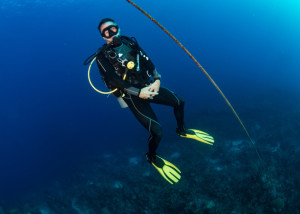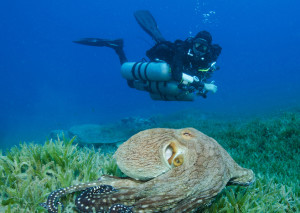How to Ascend from a Dive
 Surfacing properly when scuba diving is the key to safety.
Surfacing properly when scuba diving is the key to safety.
The post How to Ascend from a Dive appeared first on Scuba Diver Life.
How to Ascend from a Dive Read More »
 Surfacing properly when scuba diving is the key to safety.
Surfacing properly when scuba diving is the key to safety.
The post How to Ascend from a Dive appeared first on Scuba Diver Life.
How to Ascend from a Dive Read More »
 For many divers, technical diving retains an aura of being overly complicated, dangerous and too difficult for the average person. But with proper preparation, it’s none of those things. Here we’ll address a few of the top technical diving myths.
For many divers, technical diving retains an aura of being overly complicated, dangerous and too difficult for the average person. But with proper preparation, it’s none of those things. Here we’ll address a few of the top technical diving myths.
The post Top Technical Diving Myths appeared first on Scuba Diver Life.
Top Technical Diving Myths Read More »

Brad Holland
Bring scuba diving fun to the whole family with Kids Sea Camp.
“Wow” is all I can think now. We are a family of 5 that submerged ourselves in the beautiful turquoise waters of Yap, a tiny island off the beaten path for sure. The island is located in the Federated States of Micronesia. We live in Hawaii, so when I contacted Margo Peyton at Kids Sea Camp the bar was set pretty high for expectations in taking a family dive vacation. She personally guided us through a magical family adventure to Yap and Palau, and just like her tag line says, “Give them a week we will remember forever.” All our expectations were surpassed.
Surrounded by pristine reefs, large schools of fish, and plenty of large pelagics on a daily basis in Yap. On our list were sailfish, reef sharks, manta and even a rare baby whale shark encounter. Not to make less of some of the most beautiful soft corals and amazing visibility any diver could ask for.

Brad Holland
Kids can enjoy snorkeling as well as diving with Kids Sea Camp.
As I descend with my family into the blue a euphoric feeling overcomes me. But, what is really on my mind, is the fact that all three of my daughters are getting this experience along with my husband and myself together! How amazing is it to have us all be experiencing this beautiful, untouched, unspoiled, majestic destination together?
Moments to remember forever: My youngest daughter, Emma floats above my head and dives down for a “high five” as she is only 7 (A sassy) right now and is still dreaming of the day she can officially dive with us. For now she is snorkeling with sharks, learning about the ocean and doing Sassy and that will have to suffice. The view she is getting is fantastic and just as great as ours is, if not better while scuba diving. She is being circled by schools of fish and small white tip reef sharks. She shoots me a huge smile and a great big Shaka from the surface and an “OK” signal. Yeah, she is totally stoked to be part of this!
Sierra (age 11) is out in the blue, following in her dad’s footsteps with her camera just waiting for that chance to capture the perfect shot for her memories. Take only memories and leave the rest behind for the future. She is in her zone. Perfectly focused and ready for the shot. Smiling and happy as can be. She signals me a huge “OK” and I know all is good. Another “wow!” Her wish granted as out of the blue comes a juvenile whale shark, he poses inches from her lens and she has the shot.

Brad Holland
Amazing animal encounters with Kids Sea Camp.

Kids Sea Camp delivers the “wow” factor.
Jos (age 14) is busy being Brad Holland’s diving model, Brad is the professional photographer on the Manta Ray Bay Resort. It’s a perfect fit — a teen diver that has her buoyancy and diving down like a master diver. She is so into the dive that she doesn’t even notice all of the attention she is getting by the photographer. And for this short 60 minutes or so, she gets to spend with the loves of her life, manta rays and sharks. Jos is in heaven right now and there is no interrupting her. She’s just soaking in the experience. These moments at Kids Sea Camp are so magical.
Jeff, my husband is taking the opportunity to spruce up his photography skills and is loving it. He has been spoiled having Brad spend a week with him and share tips of the trade. He is pumped to be using his new found skills. And I even have a few photos of him taking photos, which is rare since he is always the one shooting the photos (thanks to Brad Holland for that).

Brad Holland
The whole family will have a fin-tastic time with Kids Sea Camp.
And me, I’m just thrilled to share this unforgettable journey to Yap and Palau with my family. This type of experience cannot be purchased in any store or found in some prepackaged deal online and it’s not going to be on a cruise ship or in a theme park.
This is a once in a lifetime opportunity created and personally hosted by Kids Sea Camp, for us to all connect and embrace the majesty of the underwater world. We don’t have to say a single word. We just look at each other and smile when we surface. We all know what each other feels, its written and plastered all over our faces. “Wow” Oh my goodness, how could it possibly get any better?
Kids Sea Camp is the perfect family experience and is a trip of a lifetime.
Thanks so much to Margo

Brad Holland
Scuba diving fun in Yap with Kids Sea Camp.

Brad Holland
Exploring the reefs with Kids Sea Camp.

Brad Holland
‘Catch some rays’ with Kids Sea Camp.

Brad Holland
We hope to ‘sea’ you soon at Kids Sea Camp!

Brad Holland
Give them a week they will remember forever with Kids Sea Camp.
Kids Sea Camp Creates Unforgettable Family Dive Trips Read More »

Steven P. Hughes
Bottom Line: Don’t Deny
Delaying treatment during the first few minutes could be the difference between a good outcome and a poor one.
It can happen to anybody. You carry two computers. They both say you’re OK. You didn’t have a rapid ascent, you didn’t go into deco, you’re hydrated, you’re rested, you’ve been deeper for longer before. But you don’t feel right after the dive. What gives?
In my case, I was diving on a three-day liveaboard trip in Southern California when I came up from a dive and immediately had moderate to severe pain in my upper abdomen, just below my diaphragm. I figured it was gas, upset stomach, anything but decompression illness. But the pain was followed shortly by my legs going numb and becoming paralyzed. I can’t be bent, I thought. I must have sat on my legs and put them to sleep.
I decided to tell the captain, who started me on oxygen right away and called the Los Angeles County paramedics stationed at Cat Harbor. Oxygen made me feel much better — so much better that I didn’t think I was hit.
The paramedics insisted I go to the chamber to be assessed. I did, and the consensus was that I had a Type 2 spinal-cord hit. After five hours in the Catalina Hyperbaric Chamber, I’m fine. No lingering symptoms.
From onset to administration of 0₂ was less than 10 minutes. From onset to the chamber ride was less than two hours. I’m convinced that quick response was the key to my resolving on the 0₂ initially and having no issues after the chamber ride.
Bottom line: Don’t deny. In my case, I told the captain I needed 0₂, but if your captain tells you — listen to him. That first few minutes could be the difference between a good outcome and a poor one. I’ve always been told the first sign of DCI is denial. I didn’t deny, and I turned out fine.
What It’s Like To Take An Unexplained Hit Read More »

Jon Whittle
Skill 84
Learning to discreetly clear your scuba mask (without leaving a bubble trail) is just one of the 100 deadly skills.

Courtesy of Clint Emerson
Clint Emerson
After spending 20 years navigating deadly situations with the National Security Agency and SEAL Team Six, Clint has just released an illustrated guide to to surviving any dangerous situation.
Clint Emerson spent 20 years navigating deadly situations with the National Security Agency and the elite SEAL Team Six. Now retired, he’s just released the illustrated 100 Deadly Skills: The SEAL Operative’s Guide to Eluding Pursuers, Evading Capture and Surviving Any Dangerous Situation, which includes scuba-friendly skills such as clearing a flooded mask without a bubble trail (No. 84), crossing enemy borders by sea (No. 11) and surviving a drowning while restrained (No. 88). We spoke with him about the secrets of his life and work (and he never even offered to kill us afterward).
Q: Were you a diver before your SEAL service?
A: Growing up in Saudi Arabia, boredom was abundant, so diving and Boy Scouts became my pastimes. I got certified as soon as I turned 12 and have never stopped diving. Learning to dive in the Persian Gulf was actually childhood “training,” prepping for an unknown future.
Q: What’s the most valuable thing about 100 Deadly Skills?
A: It’s not about becoming more deadly — it’s about becoming more safe and secure by leveraging the 100 skills. Divers travel the globe; these skills are useful for anyone traveling abroad or domestically. And people who enjoy new adventures and taking calculated risks will certainly enjoy the book.

Jon Whittle
100 Deadly Skills
The SEAL Operative’s Guide to Eluding Pursuers, Evading Capture, and Surviving Any Dangerous Situation
Q: Have you ever had to rely on your scuba skills in a life-or-death situation?
A: Fortunately, I have never had to jump from an enemy ship to my dive rig staged 20 feet below the pier — or maybe I did, hmm, I can’t remember. [Laughs.] As a kid, an adult dive partner left me behind at a tire reef in the Persian Gulf — a not-so-good dive partner, to say the least. In times of crisis, remaining calm, cool and collected becomes the most valuable tool, not having the latest, greatest gear on your back. Most of the time, the difference between life and death is how you react.
Q: What are the crucial “deadly skills” for divers?
A: As a SEAL we have several diving mantras: Never dive alone. Plan your dive, dive your plan . Don’t be scared of the dark. And dive with a full bladder, because urine is warm.
100 Deadly Skills: How To Survive Any Dangerous Situation Read More »